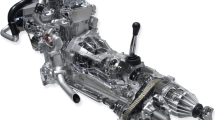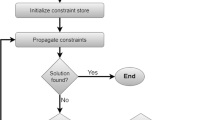Abstract
In this paper, we study the problem of transforming a job-shop layout into a flow-shop layout by introducing additional machines, so that all job-related operations can be processed in a flow-shop layout. The objective is to find the shortest sequence of machines, so that the overhead of introducing additional machines can be reduced. This transformation of job-shop layout into flow-shop layout has the advantage of automating the flow-line, which is an important step in digital manufacturing. The study first focuses on a special case (which is studied generally in the literature) where all the jobs would have the same and equal number of operations to be performed in a job-shop, but each job has a different machine routing when compared to other jobs. We propose a Mixed Integer Liner Programming (MILP) model for solving this special case. Further, in order to evaluate the performance of the proposed MILP model, we compare the same with an existing model in literature. From the results, we confirm that the proposed model is superior in terms of the CPU time, in solving the problem instances considered for the study. The study also extends this special case, and considers the generalized case where jobs could have different number of operations, and the study proposes a comprehensive MILP model for solving the generalized case.
Access this chapter
Tax calculation will be finalised at checkout
Purchases are for personal use only
Similar content being viewed by others
References
Angeles, R. (2009). Anticipated IT infrastructure and supply chain integration capabilities for RFID and their associated deployment outcomes. International Journal of Information Management, 29(3), 219–231.
Framinan and Ruiz-Usano, 2002 Framinan, J. M., & Ruiz-Usano, R. (2002). On transforming job-shops into flow-shops. Production Planning & Control, 13(2), 166-174
Framinan, J. M. (2005). Efficient heuristic approaches to transform job shops into flow shops. IIE Transactions, 37(5), 441–451.
Frank, A. G., Dalenogare, L. S., & Ayala, N. F. (2019). Industry 4.0 technologies: Implementation patterns in manufacturing companies. International Journal of Production Economics, 210, 15–26.
Gillani, F., Chatha, K. A., Jajja, M. S. S., & Farooq, S. (2020). Implementation of digital manufacturing technologies: Antecedents and consequences. International Journal of Production Economics, 229, 107748.
Kimms, A. (2000). Minimal investment budgets for flow line configuration. IIE Transactions, 32, 287–298.
Krishnaraj, J. (2021). A deterministic heuristic algorithm to minimize the length of a manufacturing line in transformation of job shops into flow shops. In Emerging frontiers in operations and supply chain management (pp. 119–135). Springer.
Lawrence, S. (1984). An experimental investigation of heuristic scheduling techniques. Supplement to Resource Constrained Project Scheduling.
Maier, D. (1978). The complexity of some problems on subsequences and supersequences. Journal of the ACM (JACM), 25(2), 322–336.
Rajendran, S., Rajendran, C., & Ziegler, H. (2010). An ant-colony algorithm to transform jobshops into flowshops: a case of shortest-common-supersequence stringology problem. In International Conference on Bio-Inspired Models of Network, Information, and Computing Systems (pp. 413–424). Springer.
Sony, M., Antony, J., & Douglas, J. A. (2020), Essential ingredients for the implementation of Quality 4.0. The TQM Journal, 32(4), 779–793.
Szalavetz, A. (2019). Digitalisation, automation and upgrading in global value chains - factory economy actors versus lead companies. Post-Communist Economies, 31(5), 646–670.
Zhou, Z., Xie, S., & Chen, D. (2012). Fundamentals of digital manufacturing science. Springer.
Acknowledgements
The first author gratefully acknowledges the support from Alexander von Humboldt Foundation, Germany, to carry out this research work in University of Passau. We are thankful to the reviewers and the Editors for their valuable comments and suggestions to improve the paper.
Author information
Authors and Affiliations
Corresponding author
Editor information
Editors and Affiliations
Rights and permissions
Copyright information
© 2023 The Author(s), under exclusive license to Springer Nature Singapore Pte Ltd.
About this chapter
Cite this chapter
Rajendran, C., Madankumar, S., Ziegler, H. (2023). A Study on Mathematical Models for Transforming the Job-Shop Layout Into Flow-Shop Layout. In: Amit, R.K., Pawar, K.S., Sundarraj, R.P., Ratchev, S. (eds) Advances in Digital Manufacturing Systems. Springer, Singapore. https://doi.org/10.1007/978-981-19-7071-9_8
Download citation
DOI: https://doi.org/10.1007/978-981-19-7071-9_8
Published:
Publisher Name: Springer, Singapore
Print ISBN: 978-981-19-7070-2
Online ISBN: 978-981-19-7071-9
eBook Packages: Business and ManagementBusiness and Management (R0)




